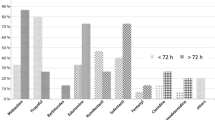Abstract
Objective
To compare the effects of opioid and nonopioid sedation on gastric emptying.
Design
Prospective, randomized trial.
Setting
University teaching hospital ICU.
Patients
21 brain injured patients requiring sedation, mechanical ventilation and intracranial pressure (ICP) monitoring for >24h.
Interventions
Patients were randomized to receive infusions of either morphine plus midazolam (M), or propofol (P). Gastric emptying was assessed by the paracetamol absorption technique and by residual volumes following a 200 ml test feed.
measuerments and results
Pre-sedation Glasgow Coma Score, mean ICP and the presence of bowel sounds were noted. Plasma concentrations of paracetamol were measured over 3 h following a 1 g gastric dose. There were no differencese in median peak paracetamol concentration (M, 18.5 versus P, 20.8 mg/l), median time to peak concentration (M, 20 versus P, 25 min), median area under the concentration-time curve (AUC), or in the median residual volumes at 1 h (M, 14 versus P, 10.5 ml) and 2 h (M, 5 versus P, 3 ml). In patients with ICP>20 mmHg, paracetamol concentrations were lower (p<0.05), and AUC after 30 min was lower (165 mg·min/l versus 411 mg·min/l,p=0.023). Mean ICP was correlated with AUC (Kendall rankp=0.027). Gastric emptying did not correlate with initial Glasgow Coma Score or presence of bowel sounds.
Conclusions
Gastric emptying is not improved in patients with brain injury by avoiding morphine (1–8 mg/h) in the sedative regimen. Intracranial hypertension is associated with reduced gastric emptying.
Similar content being viewed by others
References
Murray MJ, Marsh HM, Wochos DN, Moxness KE, Offord KP, Callaway CW (1988) Nutritional assessment of intensive-care unit patients. Mayo Clin Proc 63:1106–1115
Rapp RP, Young B, Twyman D, Bivins BA, Haak D, Tibbs PA, Bean JR (1983) The favorable effect of early parenteral feeding on survival in head-injured patients. J Neurosurg 58:906–912
Berger R, Adams L (1989) Nutritional support in the critical care setting (part1). Chest 96:139–150
Christman JW, McCain RW (1993) A sensible approach to the nutritional support of mechanically ventilated critically ill patients. Intensive Care Med 19:129–136
Berger R, Adams L (1989) Nutritional support in the critical care setting (part 2). Chest 96:372–380
Chang RWS, Jacobs S, Lee B (1987) Gastrointestinal dysfunction among intensive care unit patients. Crit Care Med 15:909–914
Ott L, Young B, Phillips R, McClain C, Adams L, Dempsey R, Tibbs, P, Ryo Y (1991) Altered gastric emptying in the head-injured patient: relationship to feed intolerance. J Neurosurg 74:738–742
Norton JA, Ott LG, McClain C, Adams L, Dempsey RJ, Haak D, Tibbs PA, Young AB (1988) Intolerance to enteral feeding in the brain injured patient. J Neurosurg 68:62–66
Bion JF, Ledingham IMcA (1987) Sedation in intensive care—a postal survey. Intensive Care Med 13:215–216
Nimmo WS, Heading RC, Wilson J, Tothill P, Prescott LF (1975) Inhibition of gastric emptying and drug absorption by narcotic analgesics. Br J Clin Pharmacol 2:509–513
Harris CE, Grounds RM, Murray AM, Lumley J, Royston D, Morgan M (1990) Propofol for long-term sedation in the intensive care unit. A comparison with papaveretum and midazolam. Anaesthesia 45:366–372
Heading RC, Nimmo J, Prescott LF, Tothill P (1973) The dependence of paracetamol absorption on the rate of gastric emptying. Br J Pharmacol 47:415–421
Gin T, Cho AMW, Lew JKL, Laus GSN, Yuen PM, Critchley JAJH, Oh TE (1991) Gastric emptying in the postpartum period. Anaesth Intensive Care 19:521–524
Critchley JAJH, Nimmo GR, Gregson CA, Woolhouse N, Prescott LF (1986) Intersubject and ethnic differences in paracetamol absorption. Br J Clin Pharmacol 22:649–657
Gainsborough N, Maskrey VL, Nelson ML, Keating J, Sherwod RA, Jackson SHD, Swift CG (1993) The association of age with gastric emptying. Age and Ageing 22:37–40
Divoll M, Ameer B, Darrell RA, Greenblatt DJ (1982) Age does not alter acetaminophen absorption. J Am Geriatr Soc 30:240–244
Mushambi MC, Rowbotham DJ, Bailey SM (1992) Gastric emptying after minor gynaecological surgery. The effect of anaesthetic technique. Anaesthesia 47:297–299
Power I, Easton JC, Todd JG, Nimmo WS (1989) Gastric empyting after head injury. Anaesthesia 44:563–566
Garrick T, Mulvihill S, Buack S, Maeda-Hagiwara M, Tache Y (1988) Intracerebroventricular pressure inhibits gastric antral and duodenal contractility but not acid secretion in conscious rabbits. Gastroenterology 95:26–31
Payne-Jones JJ, Rees RG, Silk DBA (1987) Bowel sounds. Anaesthesia 42:893–894
Shelly MP, Church JJ (1987) Bowel sounds during intermittent positive pressure ventilation. Anaesthesia 42:207–209
Author information
Authors and Affiliations
Rights and permissions
About this article
Cite this article
McArthur, C.J., Gin, T., McLaren, I.M. et al. Gastric emptying following brain injury: Effects of choice of sedation and intracranial pressure. Intensive Care Med 21, 573–576 (1995). https://doi.org/10.1007/BF01700162
Received:
Accepted:
Issue Date:
DOI: https://doi.org/10.1007/BF01700162




